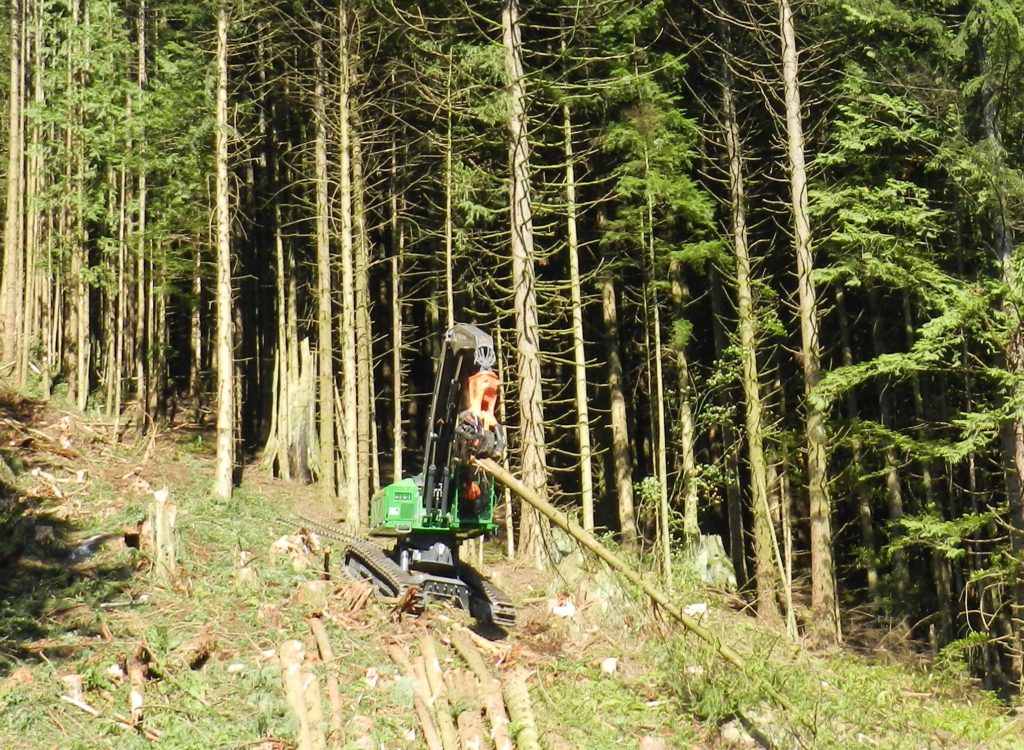“Would you like to swing on a star?/Carry moonbeams home in a jar?
And be better off than you are?/Or would you rather be a mule?”
— Bing Crosby
I don’t know about moonbeams, but the rest of Bing’s lyrics are prescient. In the late 1800’s loggers began using “steam donkeys”, or steam powered winches, to aid in skidding logs out of the forest. A recent trip to the Canadian Institute of Forestry meeting and associated DEMO International equipment show provided evidence of a modern application of this idea that is transforming steep terrain harvesting out west. Tethered or traction-assisted steep terrain operations are becoming more popular based on the successes in New Zealand and Europe. This technology pairs logging equipment with a remote-controlled winch to maintain tension between the machine and some anchor at the top of the slope. Many systems are offering continuous support of as much as 8-10 tons to assist the machines in traversing up and down steep slopes, minimizing wheel or track slippage. To an operator looking uphill on some of these slopes, it must look like they are swinging from a star. Tethered systems are making mechanized felling on steep terrains a legitimate possibility, replacing one of the most labor intensive and dangerous operations, manual felling.

Logging remains one of the most dangerous occupations based on work-related fatalities. Being struck by a falling object accounts for over 50% of the fatalities in logging. Getting more workers operating within the confines of safety cabs will reduce this number. Many of the manual felling jobs in the US are in Appalachia and the Northwest, where steep terrains have limited the ability to fell trees mechanically.
While safety advantages are obvious, tethered operations also offer the potential for a significant costs savings. Taking a job which requires multiple people with high worker’s compensation rates and replacing them with a felling machine offers the potential to significantly decrease the cost of felling on steep slopes. A felling machine can align logs ideally for easier extraction as well. Forisk’s estimates of western logging costs have labor as nearly half of the total harvesting cost, much greater than any other region of the country. We recently reported on the growing logging productivity in Western operations, and adoption of this technology could be a further step up in productivity.
While these machines are making their way into the West, their potential may be even greater. Over 30% of the growing stock volume on private timberlands in Appalachia (Kentucky, Tennessee, and West Virginia) is on slopes greater than 40%. For comparison, 27% of growing stock volumes on private lands in Oregon and Washington are on similarly steep ground. Cable logging operations have largely struggled in Appalachia, and the development of mechanized steep terrain operations has offered additional options to harvest some of these stands. Traction assist technologies may be a valuable opportunity on the short, steep slopes of the Appalachian Mountains.
Felling is only part of the problem, however. Extraction remains the more challenging aspect. No one wants to see skid roads running directly downhill, creating perfect water channels. European operations benefit from the prevalence of cut-to-length harvesters that create a mat of logging debris over which their forwarders can drive up and down the slope. Feller-bunchers don’t offer a similar layer of protection. There are still some concerns that need addressing, but the technology could hold significant benefits in areas where forests on steeper slopes have not previously been accessible for mechanized harvesting. Or would you rather use a mule?

Leave a Reply